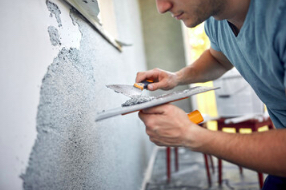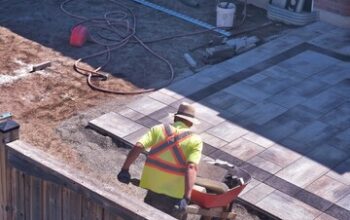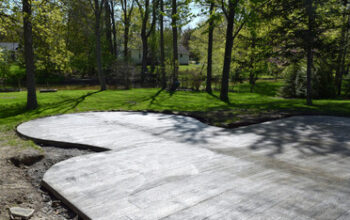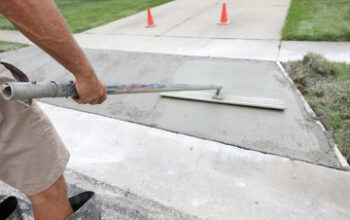Concrete repair can be intimidating, especially when it involves structures in high places. Working with a contractor with experience, training, insurance, and safety credentials is important. A basic inspection should include observation of the surface and sounding the concrete (using a hammer) to identify delaminated areas that don’t make the hard ring of sound concrete. For professional help, call Concrete Contractors Dallas TX.
If a crack in concrete is not repaired, it will worsen and may lead to more serious problems. It is best to hire a professional to handle the repair. They have the knowledge and experience to ensure the crack is filled properly to prevent water leaks and foundation settlement. In addition, professional contractors have the proper tools to do the job safely and efficiently.
The first step in repairing concrete cracks is to evaluate the structure’s condition. This includes a visual inspection, destructive and nondestructive testing, a review of maintenance records, a structural analysis, and an evaluation of the causes of deterioration and distress. The results of the evaluation will determine the appropriate repair method and materials.
There are many ways to repair concrete cracks, including epoxy injection, mortar patching, and urethane sealants. Injection methods inject the crack with a special material that binds to the existing concrete and prevents further damage. This technique is most effective for small cracks that are not actively widening.
Another popular method is concrete stitching. This procedure involves drilling entry and exit holes across the crack. Then, the crack is stitched together using a series of U-shaped metal staples. This is a cost-effective and long-lasting solution that is suitable for both new and old concrete.
For larger cracks, it is usually necessary to fill the crack with a cement-based product. The material should have similar properties to the surrounding concrete, including a low water-to-cement ratio and a high percentage of aggregate. In addition, the concrete filler should have good tensile strength, freeze-thaw resistance, and abrasion resistance.
It is important to repair concrete cracks because they can cause injuries if someone trips over them. Also, they can make a home or business look unkempt and unprofessional. A concrete contractor can help prevent accidents and keep your property looking great.
When hiring a concrete contractor, be sure to find one that offers warranties and insurance. This will protect you in the event of an accident or a problem with the work. It is also a good idea to choose a contractor who has experience working on commercial and residential properties.
Repairing Holes
There are a number of ways to repair holes in concrete, ranging from simple patch mixes to more permanent repairs using foamed-in-place or precast slabs. Whatever method you choose, it’s vital to prepare the damaged area properly before applying the concrete product. Especially with hole repairs, it’s important to remove all loose debris and impurities that can compromise the bond between the new concrete and the existing concrete. If left behind, these “contaminants” can create long-term problems such as mold and mildew.
This can be done by sweeping or vacuuming the damaged area, or it can be power washed (as long as you don’t use a high-pressure sprayer). If you do opt to power wash, it’s important to wear safety equipment, such as a hard hat, goggles, and work gloves. It’s also wise to moisten the area to be repaired to prevent the concrete patch mix from drying out too quickly.
If you’re repairing a small hole, you can usually just apply a latex cement product to the damaged area. Larger holes may require reforming the broken concrete, including digging down a few inches and adding a gravel base. Once the area is prepared, you can then rebuild the hole using a concrete patch mix and a trowel, smoothing afterward with a trowel.
For larger holes, it’s usually best to reform the broken concrete by digging down a few inches and adding sand or gravel before adding the concrete patch mixture. This allows you to rebuild the hole to its original shape and provides a stronger foundation. It also makes it easier to level and smooth the patched surface with a trowel, after which you can finish with a concrete broom.
When working with concrete repair, it’s always a good idea to follow the manufacturer’s instructions for mixing the product. It’s also a good idea to estimate the size of your repair area so you can buy enough concrete patch mix to get the job done. For example, a small hole measuring 2″ x 2″ x 6″ requires one pound of Sakrete Fast Setting Cement Patcher, while a larger repair might need two pounds of the same product.
Sealing Cracks
In some cases, cracks in concrete need to be sealed instead of repaired. If they are not sealed, the cracks can continue to grow and may cause further damage to the concrete. Crack sealing involves pouring a material into the cracks to stop water penetration. This can be done with a variety of products, including concrete caulks and fillers, sealants, or concrete patching compounds. The best product for the job will depend on the size of the crack, its exposure to weather extremes and moisture, and the cause of the cracking.
One option is to use a chemical-based product that will form an immediate bond with the concrete. This option is typically used in a nonstructural application, such as repairing spalled or delaminated concrete or stopping leaks. Other options for a structural repair include epoxy injection and crack welding. These techniques can be expensive, and a skilled contractor is required to perform them correctly.
When a concrete crack is filled, it is critical that the crack be cleaned and free of dust and loose debris. This will allow the new concrete to properly adhere to the old concrete. It is also important to use a bond breaker, which is usually a polyethylene sheet. This will prevent the patch from adhering to the steel reinforcement within the concrete, which can lead to corrosion and further deterioration of the concrete.
Another option for repairing cracks in concrete is to inject a chemical-based epoxy into the crack to seal it. This can be used for structural repairs and to prevent water flow through cracks. This method is generally more expensive than other alternatives, and a skilled contractor is needed to perform the injection correctly.
A concrete repair contractor can save you time, money, and headaches by completing the work properly the first time. They have the expertise to assess the extent of the damage and determine the best approach for repair, and they can guide you with preventative maintenance to minimize future damage and avoid costly repairs. They will also have the proper equipment and high-quality materials to get the job done quickly and efficiently.
Repairing loose concrete
Even when concrete is poured properly, cracks and other damage occur over time. Rather than waiting for these problems to get worse, repair them now with a concrete patch or mortar mix. The first step is to thoroughly clean the damaged area. Remove any loose dirt, debris, or concrete chips. This is particularly important for older patios and driveways that have been through many freeze-thaw cycles.
Use a stiff brush to scrub the surface and a hammer or chisel in combination with a mason’s chisel to chip away soft or crumbling areas. Be careful not to chip too much concrete, as this can weaken the remaining slab and cause additional cracking.
For larger repairs, such as a cracked corner of a sidewalk or slab, dig down a few inches and add a gravel base to provide better support for the repair. Once this is done, you can reform the broken section by mixing a concrete patch or mortar mix with water and acrylic fortifier according to the product instructions. Mix only enough water so that the mix is wet but not so wet that it’s runny or dripping. If the patch is too wet, it won’t bond to the old concrete, and it will fail faster. After the patch is dry, it’s a good idea to apply a concrete and paver sealer to protect it from future damage.



